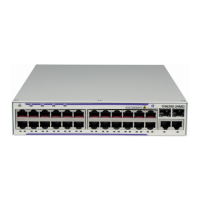VPRN Service Configuration Commands
Page 606 7210 SAS M Services Guide
The ip-addr configured here can be either on the network side or the access side on this node.
This address must be associated with a network directly connected to a network configured on
this node.
ipsec-tunnel ipsec-tunnel-name — specifies an IPSec tunnel name up to 32 characters in length.
indirect ip-address — Specifies that the route is indirect and specifies the next hop IP address used to
reach the destination.
The configured ip-addr is not directly connected to a network configured on this node. The
destination can be reachable via multiple paths. The static route remains valid as long as the
address configured as the indirect address remains a valid entry in the routing table. Indirect
static routes cannot use an ip-prefix/mask to another indirect static route.
The indirect keyword and the next-hop or black-hole keywords are mutually exclusive. If an
identical command is entered (with the exception of either the next-hop or black-hole
parameters), then this static route will be replaced with the newly entered command and unless
specified the respective defaults for preference and metric will be applied.
The ip-addr configured can be either on the network or the access side and is normally at least
one hop away from this node.
black-hole — Specifies a black hole route meaning that if the destination address on a packet
matches this static route it will be silently discarded.
The black-hole keyword is mutually exclusive with either the next-hop or indirect keywords. If
an identical command is entered, with exception of either the next-hop or indirect parameters,
then the static route is replaced with the new command, and unless specified, the respective
defaults for preference and metric are applied.
preference preference — The preference of this static route (as opposed to the routes from different
sources such as BGP or OSPF), expressed as a decimal integer. When modifying the preference
value of an existing static route, unless specified, the metric will not change.
If multiple routes are learned with an identical preference using the same protocol, the lowest
cost route is used. If multiple routes are learned with an identical preference using the same
protocol and the costs (metrics) are equal, then the decision of which route to use is determined
by the configuration of the ECMP command.
Default 5
Values 1 — 255
metric metric —
The cost metric for the static route, expressed as a decimal integer. This value is
used when importing this static route into other protocols such as OSPF. This value is also used
to determine the static route to install in the forwarding table: When modifying the metrices of an
existing static route, unless specified, the preference will not change.
If there are multiple static routes with the same preference but unequal metrices, the lower cost
(metric) route is installed. If there are multiple static routes with equal preference and metrics
then ECMP rules apply. If there are multiple routes with unequal preferences, then the lower
preference route is installed.
Default 1
Values 0 — 65535
tag — Adds a 32-bit integer tag to the static route. The tag is used in route policies to control
distribution of the route into other protocols.

